towing TOYOTA TUNDRA 2011 2.G Owners Manual
[x] Cancel search | Manufacturer: TOYOTA, Model Year: 2011, Model line: TUNDRA, Model: TOYOTA TUNDRA 2011 2.GPages: 732, PDF Size: 16.65 MB
Page 3 of 732

1
2
3
4
5
6
7
3
2-3. Operating the lights and wipers
Headlight switch .................. 212
Fog light switch ................... 216
Windshield wipers and washer .............................. 217
2-4. Using other driving systems Cruise control ...................... 220
Intuitive parking assist......... 223
Rear view monitor system... 229
Four-wheel drive system ..... 236
AUTO LSD system.............. 240
Driving assist systems ........ 243
2-5. Driving information Off-road precautions ........... 251
Cargo and luggage ............. 256
Vehicle load limits ............... 259
Winter driving tips ............... 261
Trailer towing ...................... 265
Dinghy towing ..................... 288 3-1. Using the air conditioning
system and defogger
Automatic air conditioning system .............................. 292
Manual air conditioning system .............................. 301
Outside rear view mirror defoggers and front
windshield wiper de-icer
(if equipped on Regular
Cab and Double Cab
models) ............................ 309
Back window, outside rear view mirror defoggers and
front windshield wiper
de-icer (if equipped on
CrewMax models) ............ 311
3-2. Using the audio system Audio system types ............ 314
Using the radio ................... 318
Using the CD player ........... 326
Playing MP3 and WMA discs ................................. 335
Operating an iPod .............. 343
Operating a USB memory ............................ 349
Optimal use of the audio system .............................. 356
Using the AUX port............. 360
Using the steering wheel audio switches.................. 362
3Interior and exterior
features
Page 92 of 732
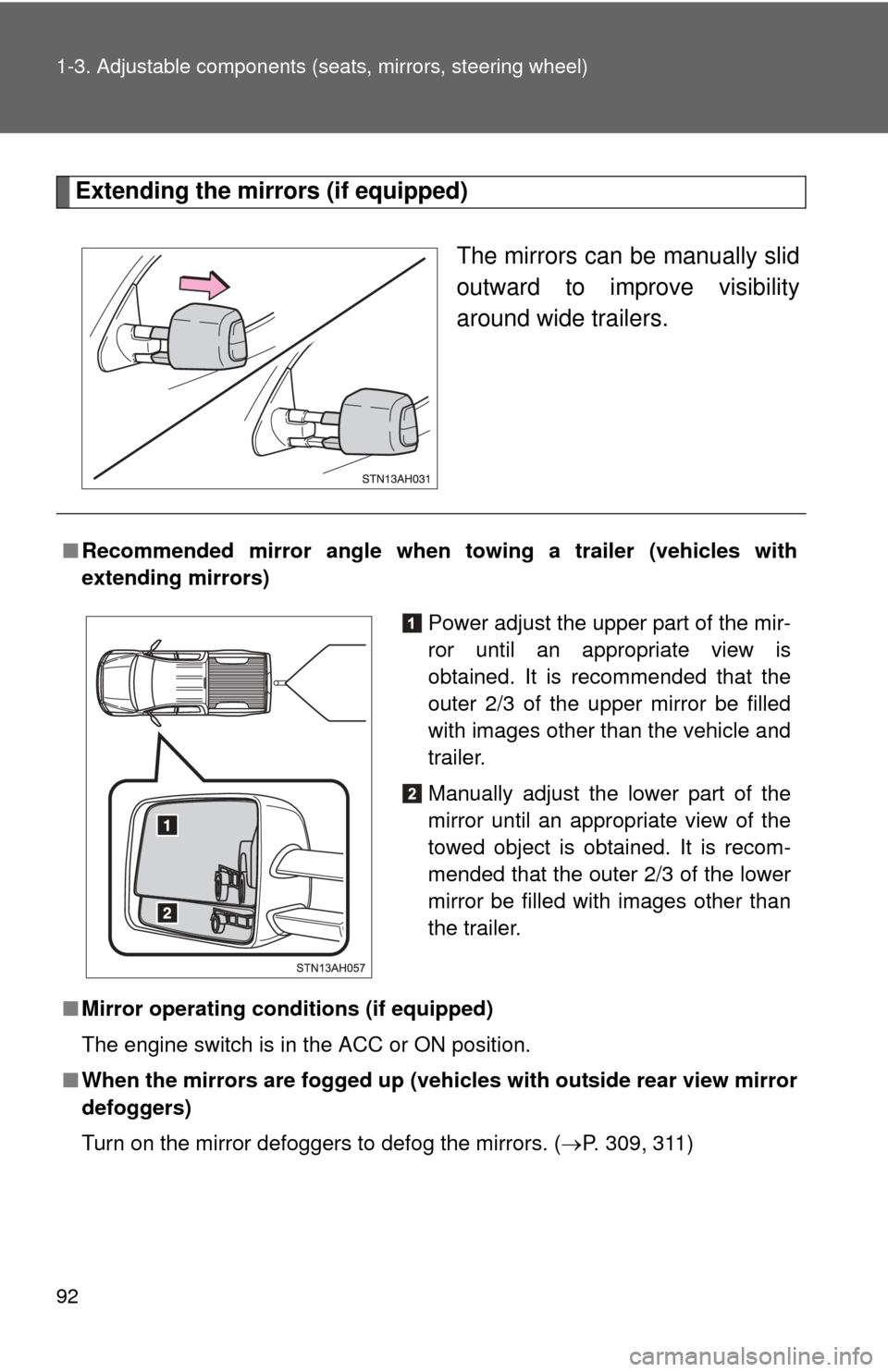
92 1-3. Adjustable components (seats, mirrors, steering wheel)
Extending the mirrors (if equipped)
The mirrors can be manually slid
outward to improve visibility
around wide trailers.
■Recommended mirror angle when towing a trailer (vehicles with
extending mirrors)
■ Mirror operating conditions (if equipped)
The engine switch is in the ACC or ON position.
■ When the mirrors are fogged up (veh icles with outside rear view mirror
defoggers)
Turn on the mirror defoggers to defog the mirrors. ( P. 309, 311)
Power adjust the upper part of the mir-
ror until an appropriate view is
obtained. It is recommended that the
outer 2/3 of the upper mirror be filled
with images other than the vehicle and
trailer.
Manually adjust the lower part of the
mirror until an appropriate view of the
towed object is obtained. It is recom-
mended that the outer 2/3 of the lower
mirror be filled with images other than
the trailer.
Page 171 of 732
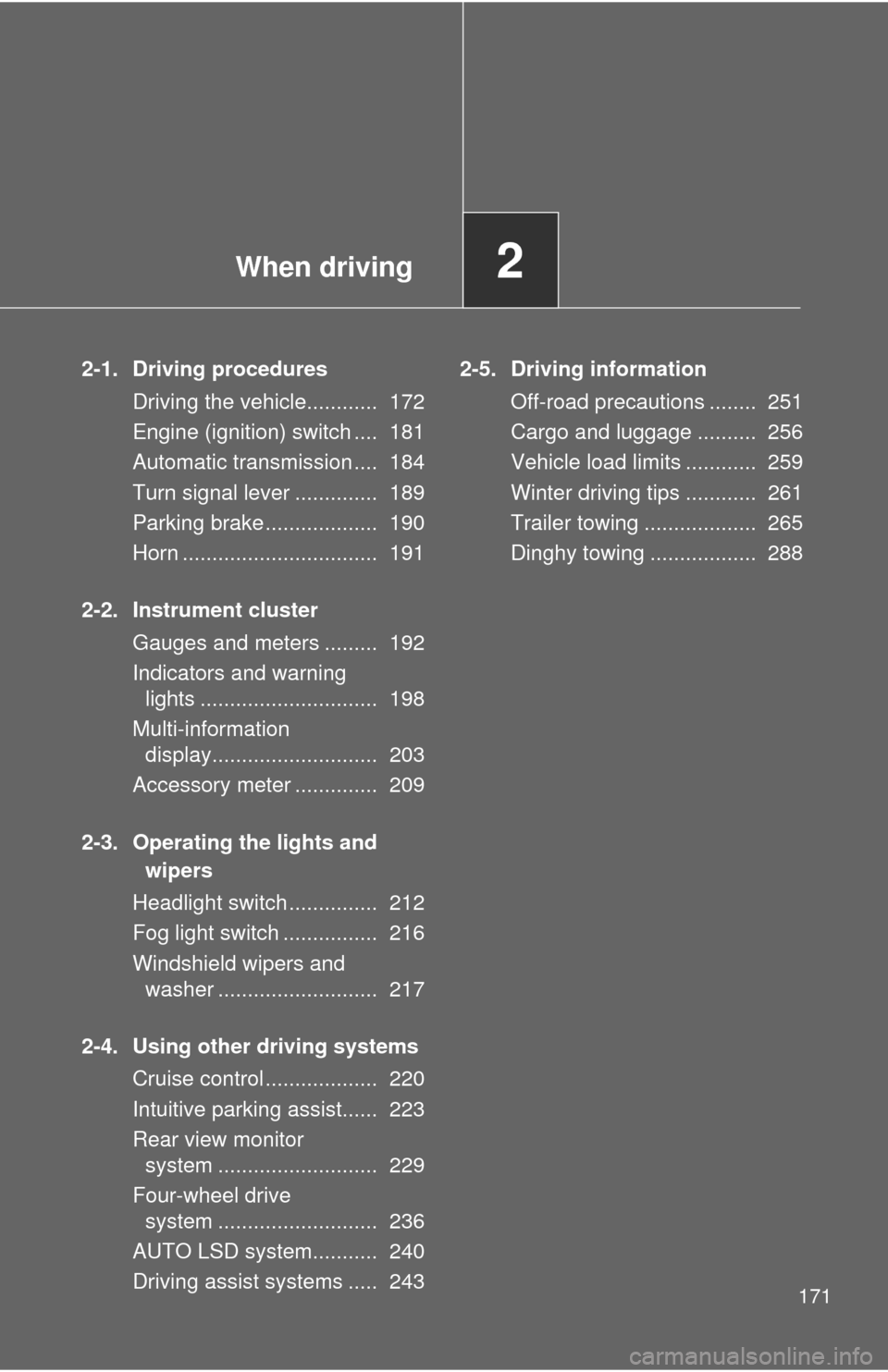
When driving2
171
2-1. Driving proceduresDriving the vehicle............ 172
Engine (ignition) switch .... 181
Automatic transmission .... 184
Turn signal lever .............. 189
Parking brake ................... 190
Horn ................................. 191
2-2. Instrument cluster Gauges and meters ......... 192
Indicators and warning lights .............................. 198
Multi-information display............................ 203
Accessory meter .............. 209
2-3. Operating the lights and wipers
Headlight switch ............... 212
Fog light switch ................ 216
Windshield wipers and washer ........................... 217
2-4. Using other driving systems Cruise control ................... 220
Intuitive parking assist...... 223
Rear view monitor system ........................... 229
Four-wheel drive system ........................... 236
AUTO LSD system........... 240
Driving assist systems ..... 243 2-5. Driving information
Off-road precautions ........ 251
Cargo and luggage .......... 256
Vehicle load limits ............ 259
Winter driving tips ............ 261
Trailer towing ................... 265
Dinghy towing .................. 288
Page 187 of 732
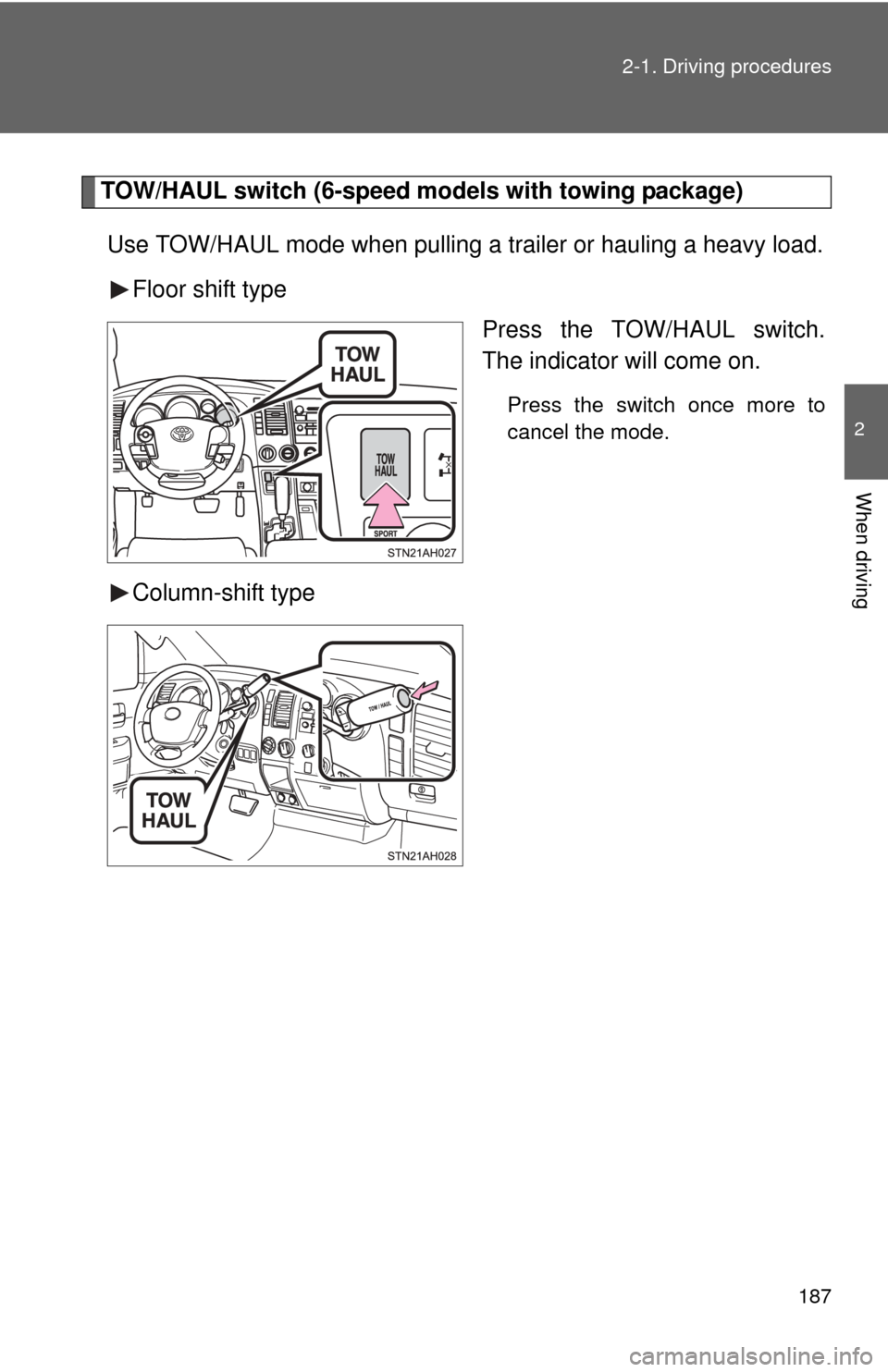
187
2-1. Driving procedures
2
When driving
TOW/HAUL switch (6-speed
models with towing package)
Use TOW/HAUL mode when pulling a trailer or hauling a heavy load. Floor shift type Press the TOW/HAUL switch.
The indicator will come on.
Press the switch once more to
cancel the mode.
Column-shift type
Page 214 of 732
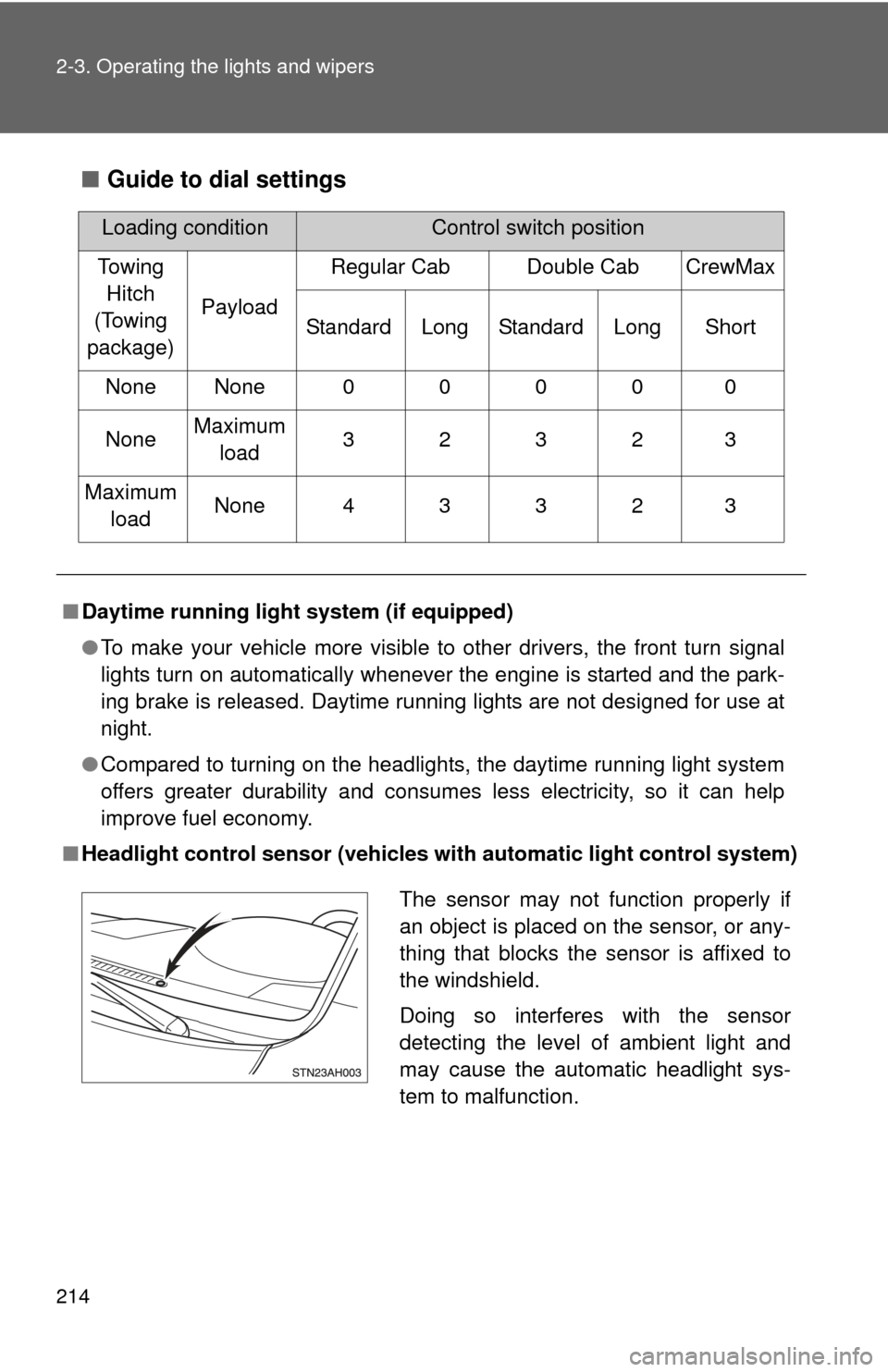
214 2-3. Operating the lights and wipers
■Guide to dial settings
Loading conditionControl switch position
Towing Hitch
(Towing
package) Payload Regular Cab Double Cab CrewMax
Standard Long Standard Long Short
None None 0 0 0 0 0
None Maximum
load 32323
Maximum load None 4 3 3 2 3
■ Daytime running light system (if equipped)
●To make your vehicle more visible to other drivers, the front turn signal
lights turn on automatically whenever the engine is started and the park-
ing brake is released. Daytime running lights are not designed for use at
night.
● Compared to turning on the headlights, the daytime running light system
offers greater durability and consumes less electricity, so it can help
improve fuel economy.
■ Headlight control sensor (vehicles wi th automatic light control system)
The sensor may not function properly if
an object is placed on the sensor, or any-
thing that blocks the sensor is affixed to
the windshield.
Doing so interferes with the sensor
detecting the level of ambient light and
may cause the automatic headlight sys-
tem to malfunction.
Page 222 of 732
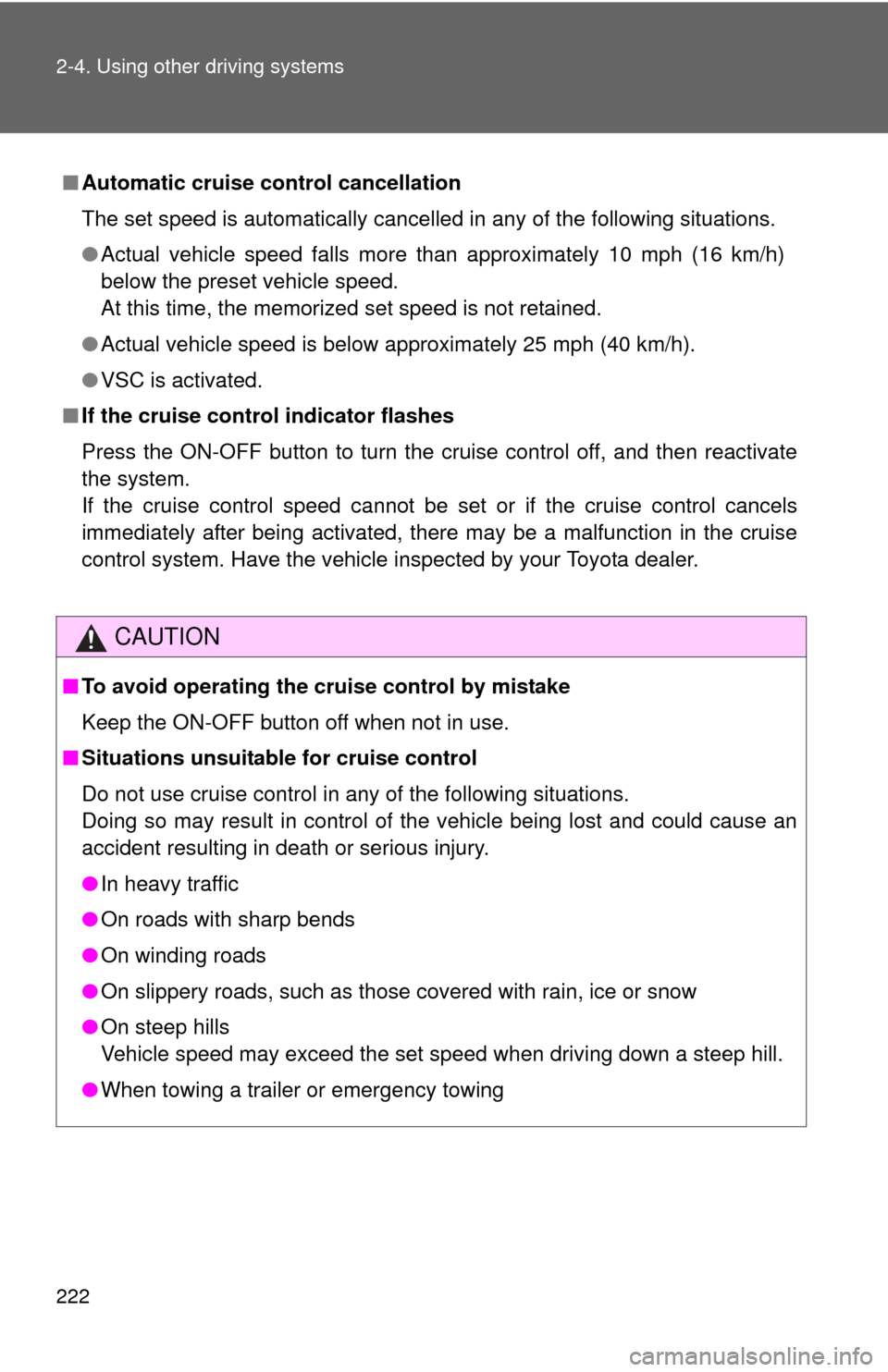
222 2-4. Using other driving systems
■Automatic cruise control cancellation
The set speed is automatically cancelled in any of the following situations.
●Actual vehicle speed falls more than approximately 10 mph (16 km/h)
below the preset vehicle speed.
At this time, the memorized set speed is not retained.
● Actual vehicle speed is below approximately 25 mph (40 km/h).
● VSC is activated.
■ If the cruise control indicator flashes
Press the ON-OFF button to turn the cruise control off, and then reactivate
the system.
If the cruise control speed cannot be set or if the cruise control cancels
immediately after being activated, there may be a malfunction in the cruise
control system. Have the vehicle inspected by your Toyota dealer.
CAUTION
■To avoid operating the cruise control by mistake
Keep the ON-OFF button off when not in use.
■ Situations unsuitable for cruise control
Do not use cruise control in any of the following situations.
Doing so may result in control of the vehicle being lost and could cause an
accident resulting in death or serious injury.
●In heavy traffic
● On roads with sharp bends
● On winding roads
● On slippery roads, such as those covered with rain, ice or snow
● On steep hills
Vehicle speed may exceed the set speed when driving down a steep hill.
● When towing a trailer or emergency towing
Page 227 of 732
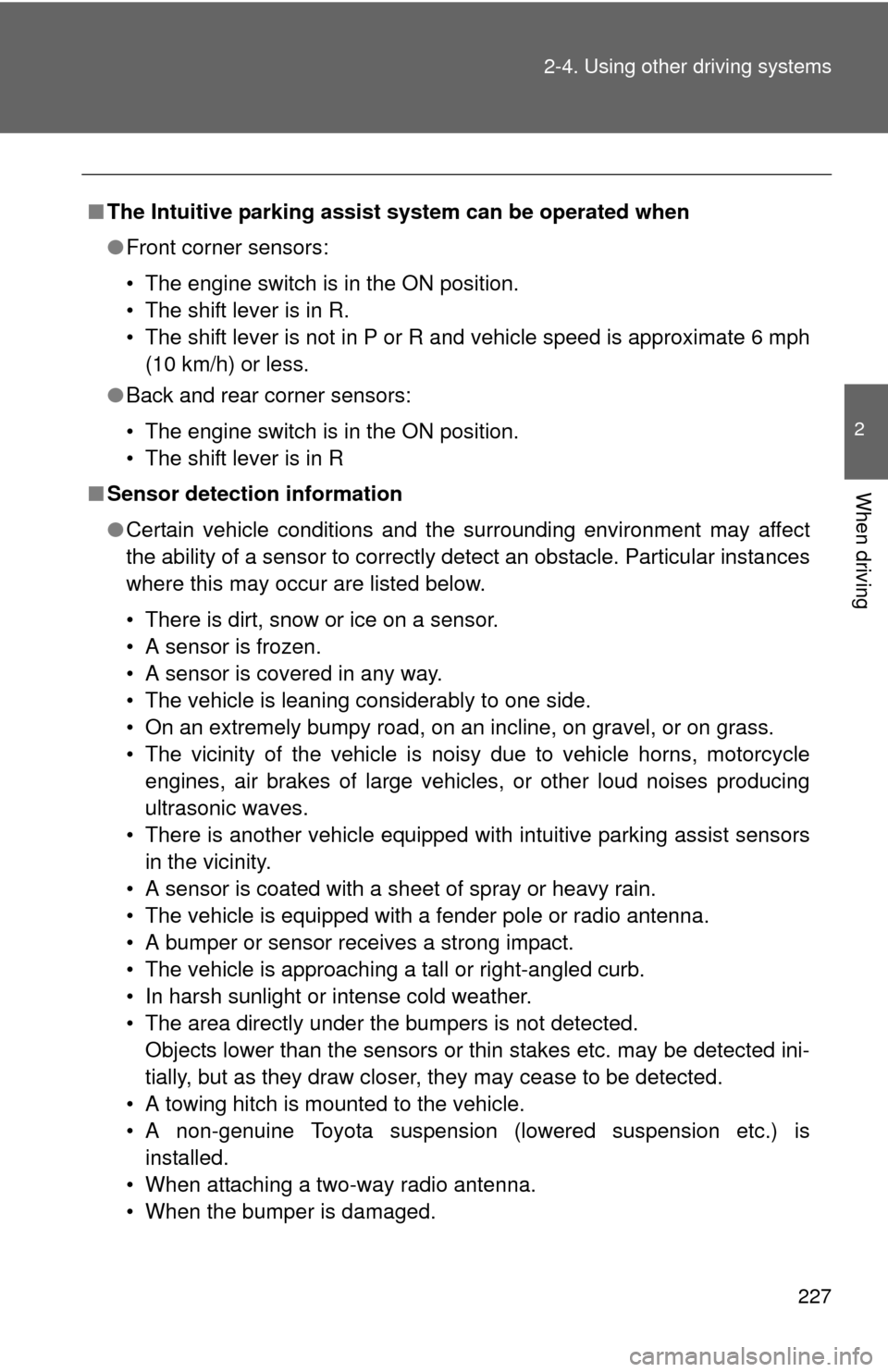
227
2-4. Using other
driving systems
2
When driving
■The Intuitive parking assist system can be operated when
●Front corner sensors:
• The engine switch is in the ON position.
• The shift lever is in R.
• The shift lever is not in P or R and vehicle speed is approximate 6 mph
(10 km/h) or less.
● Back and rear corner sensors:
• The engine switch is in the ON position.
• The shift lever is in R
■ Sensor detection information
●Certain vehicle conditions and the surrounding environment may affect
the ability of a sensor to correctly detect an obstacle. Particular instances
where this may occur are listed below.
• There is dirt, snow or ice on a sensor.
• A sensor is frozen.
• A sensor is covered in any way.
• The vehicle is leaning considerably to one side.
• On an extremely bumpy road, on an incline, on gravel, or on grass.
• The vicinity of the vehicle is noisy due to vehicle horns, motorcycle
engines, air brakes of large vehicles, or other loud noises producing
ultrasonic waves.
• There is another vehicle equipped with intuitive parking assist sensors in the vicinity.
• A sensor is coated with a sheet of spray or heavy rain.
• The vehicle is equipped with a fender pole or radio antenna.
• A bumper or sensor receives a strong impact.
• The vehicle is approaching a tall or right-angled curb.
• In harsh sunlight or intense cold weather.
• The area directly under the bumpers is not detected. Objects lower than the sensors or thin stakes etc. may be detected ini-
tially, but as they draw closer, they may cease to be detected.
• A towing hitch is mounted to the vehicle.
• A non-genuine Toyota suspension (lowered suspension etc.) is installed.
• When attaching a two-way radio antenna.
• When the bumper is damaged.
Page 257 of 732
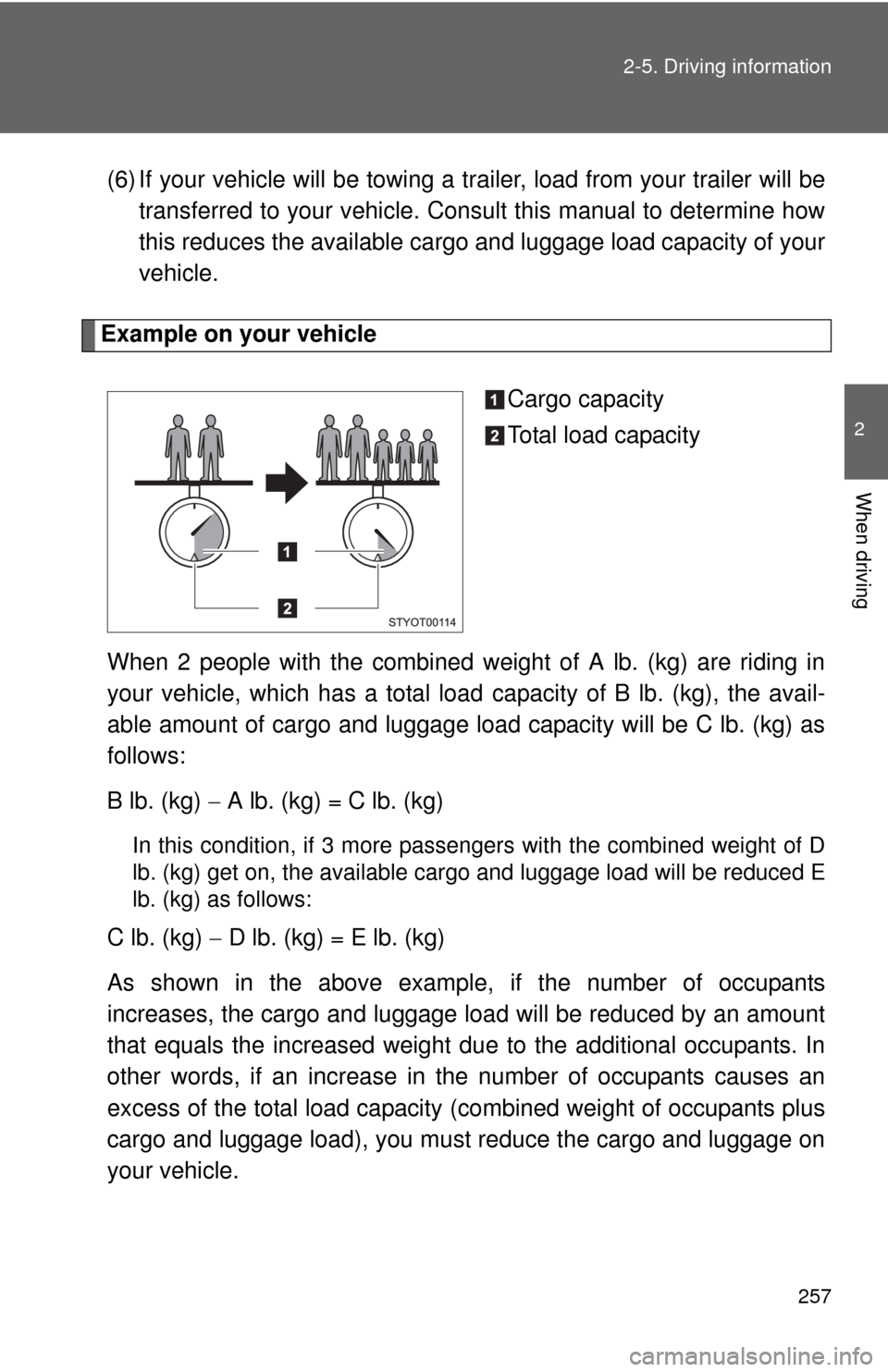
257
2-5. Driving information
2
When driving
(6) If your vehicle will be towing a tr
ailer, load from your trailer will be
transferred to your vehicle. Consult this manual to determine how
this reduces the available cargo and luggage load capacity of your
vehicle.
Example on your vehicle
Cargo capacity
Total load capacity
When 2 people with the combined weight of A lb. (kg) are riding in
your vehicle, which has a total load capacity of B lb. (kg), the avail-
able amount of cargo and luggage load capacity will be C lb. (kg) as
follows:
B lb. (kg) A lb. (kg) = C lb. (kg)
In this condition, if 3 more passengers with the combined weight of D
lb. (kg) get on, the available carg o and luggage load will be reduced E
lb. (kg) as follows:
C lb. (kg) D lb. (kg) = E lb. (kg)
As shown in the above example, if the number of occupants
increases, the cargo and luggage load will be reduced by an amount
that equals the increased weight du e to the additional occupants. In
other words, if an increase in th e number of occupants causes an
excess of the total load capacity (combined weight of occupants plus
cargo and luggage load), you must reduce the cargo and luggage on
your vehicle.
Page 265 of 732
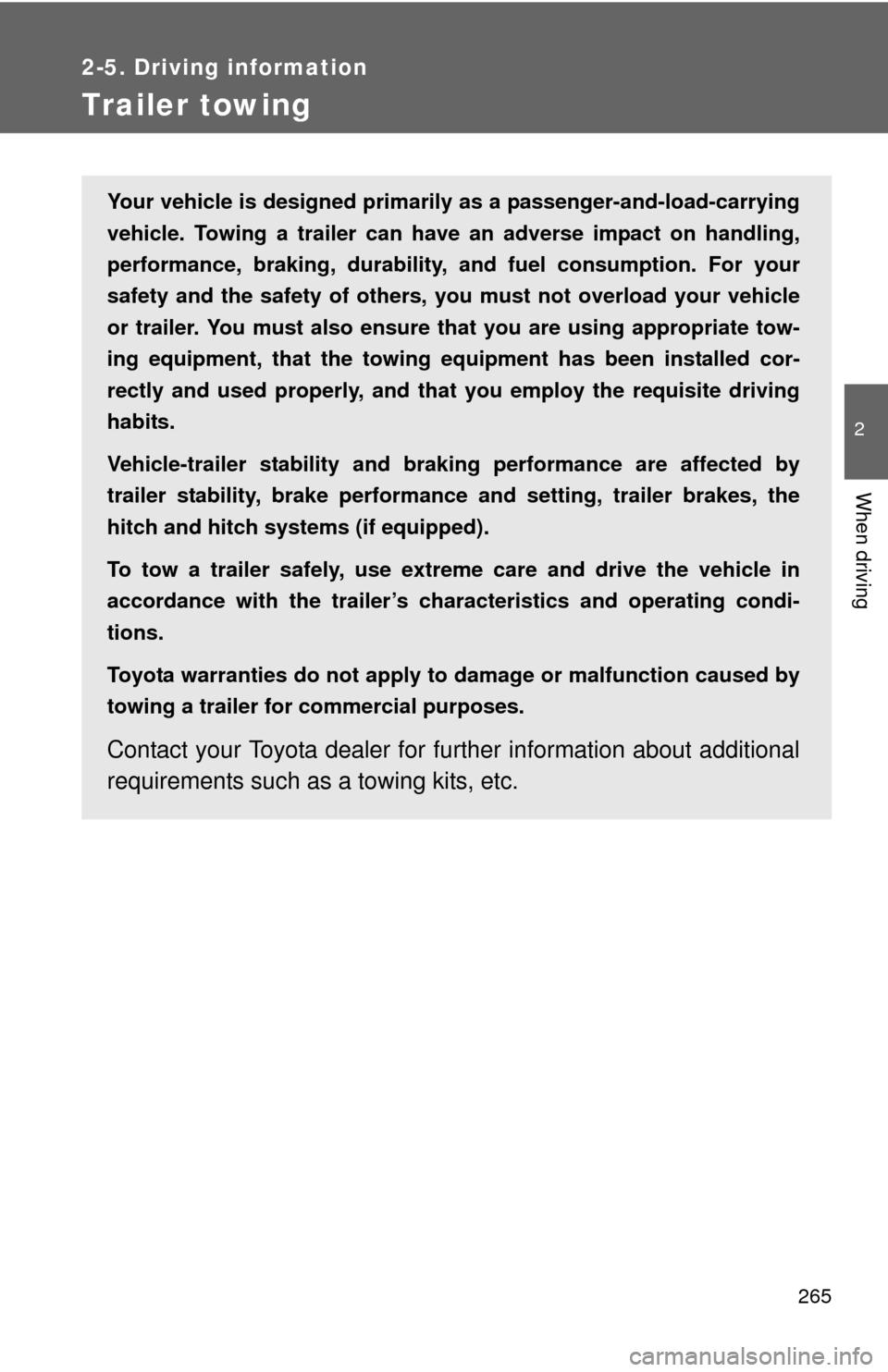
265
2-5. Driving information
2
When driving
Trailer towing
Your vehicle is designed primarily as a passenger-and-load-carrying
vehicle. Towing a trailer can have an adverse impact on handling,
performance, braking, durability, and fuel consumption. For your
safety and the safety of others, yo u must not overload your vehicle
or trailer. You must also ensure that you are using appropriate tow-
ing equipment, that the towing eq uipment has been installed cor-
rectly and used properly, and that you employ the requisite driving
habits.
Vehicle-trailer stability and braki ng performance are affected by
trailer stability, brake performance and setting, trailer brakes, the
hitch and hitch systems (if equipped).
To tow a trailer safely, use extreme care and drive the vehicle in
accordance with the trailer’s char acteristics and operating condi-
tions.
Toyota warranties do not apply to damage or malfunction caused by
towing a trailer for commercial purposes.
Contact your Toyota dealer for fu rther information about additional
requirements such as a towing kits, etc.
Page 266 of 732
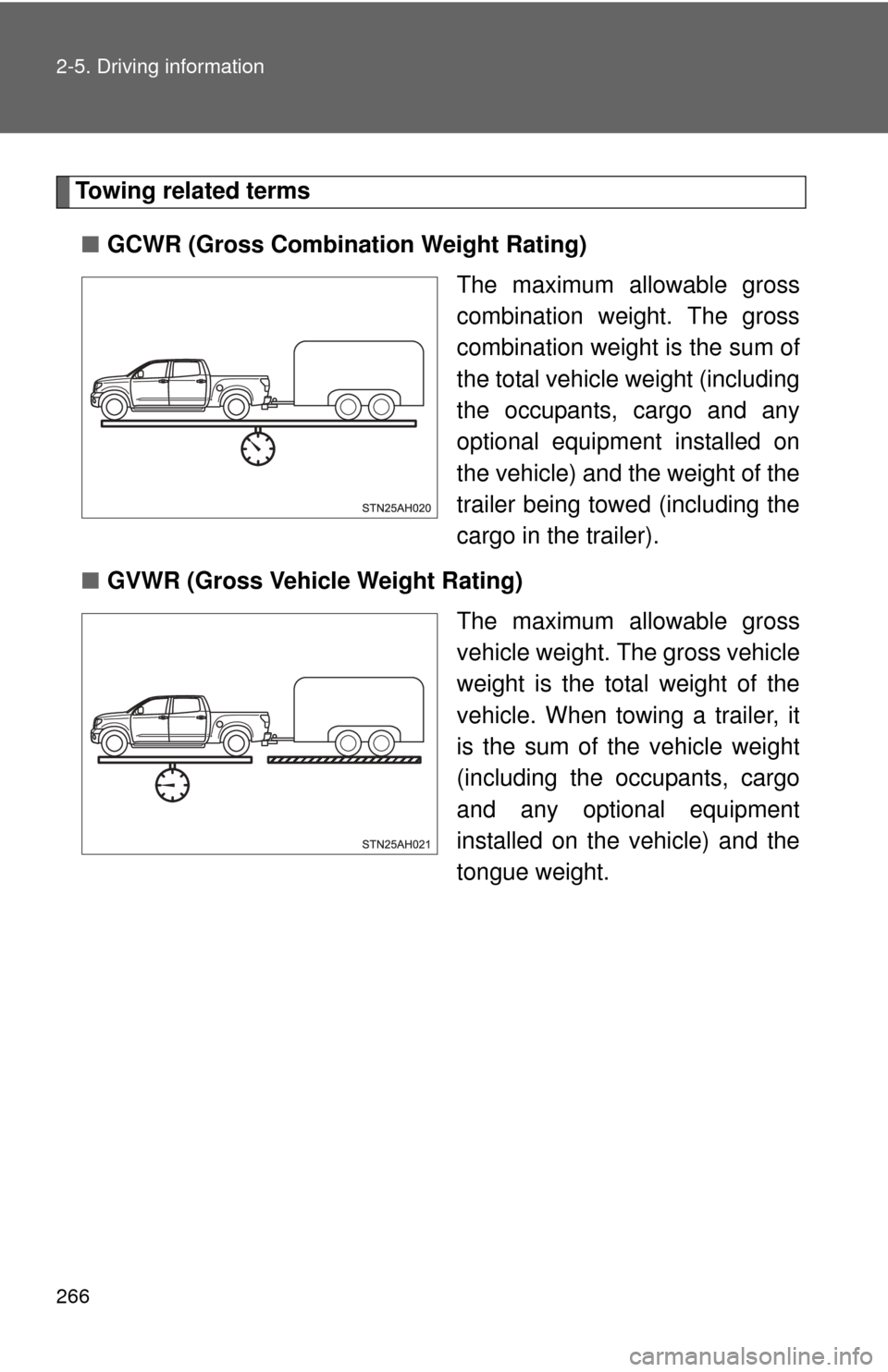
266 2-5. Driving information
Towing related terms■ GCWR (Gross Combination Weight Rating)
The maximum allowable gross
combination weight. The gross
combination weight is the sum of
the total vehicle weight (including
the occupants, cargo and any
optional equipment installed on
the vehicle) and the weight of the
trailer being towed (including the
cargo in the trailer).
■ GVWR (Gross Vehi cle Weight Rating)
The maximum allowable gross
vehicle weight. The gross vehicle
weight is the total weight of the
vehicle. When towing a trailer, it
is the sum of the vehicle weight
(including the occupants, cargo
and any optional equipment
installed on the vehicle) and the
tongue weight.